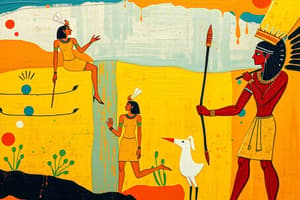Podcast
Questions and Answers
What is the approximate age of the oldest known paintings?
What is the approximate age of the oldest known paintings?
32,000 years
Which pigments were primarily used in most cave art?
Which pigments were primarily used in most cave art?
- Red pigments from iron oxides (correct)
- Black pigments from manganese dioxide (correct)
- Yellow pigments from ochre
- Green pigments from plants
Cave art may have served religious or symbolic purposes.
Cave art may have served religious or symbolic purposes.
True (A)
Which Kingdom focused on life after death in art?
Which Kingdom focused on life after death in art?
What structure is considered the first true pyramid?
What structure is considered the first true pyramid?
Which architectural feature was first used by the Egyptians?
Which architectural feature was first used by the Egyptians?
What does ARETE represent in Greek culture?
What does ARETE represent in Greek culture?
Who led the Minoan Civilization?
Who led the Minoan Civilization?
What was the focus of Greek Art during the Classical Period?
What was the focus of Greek Art during the Classical Period?
Match the Greek architectural orders with their characteristics:
Match the Greek architectural orders with their characteristics:
Flashcards are hidden until you start studying
Study Notes
Prehistoric Period/Cave Art
- Originates around 32,000 years ago, with earliest paintings found in Grotte-Vhauvet, France.
- Depictions include animals such as horses, rhinoceroses, lions, buffalo, and mammoths.
- Significant cave paintings discovered in Altamira, Spain, highlight the diversity of prehistoric art.
- Cave art, dated from the Ice Age (40,000 to 14,000 years ago), is primarily located in Europe.
- Commonly used materials: red pigments from iron oxides and black pigments from manganese dioxide and charcoal.
- Likely served religious or symbolic purposes, possibly linked to Shamanic beliefs.
Egyptian Painting
- Emphasizes conceptual representation over sensory experience.
- Hieroglyphics, an early form of picture writing, is recognized as the first art form.
Development Stages
- Old Kingdom: Art focused on worship and the afterlife.
- Middle Kingdom: Art reflects local wars and daily life, including dance and hunting.
- New Kingdom: Art primarily found in rock tombs, illustrating funerals and pilgrimages.
Architecture
- Notable for building skills, first utilizing stone columns in construction.
- Structures characterized by accuracy, precision, and geometric forms, including temples, palaces, and obelisks.
Pyramids
- Constructed during the Old and Middle Kingdoms.
- The Step Pyramid of Sakkara is considered the first true pyramid.
- The Great Pyramid of Giza, built by King Cheops, is one of the Seven Wonders of the World.
Temples
- Functioned as homes for the gods, used for worship and agricultural rites.
Sculptures
- Pharaohs depicted larger to signify power; figures are symmetrical and solemn.
- Art often fulfills both religious and propagandistic roles.
Greek Art and Civilizations
- Greece regarded as "The Glory that was Greece," emphasizing its role in Western civilization.
- ARETE principle prioritized excellence and personal growth in Greek culture.
Minoan Civilization (c. 2600 BCE)
- Ruled by King Minos; known for advanced use of bronze and gold.
- The Palace of Knossos featured 800 rooms with intricate frescoes.
- Skilled artisans in fresco painting, stone carving, and pottery; engaged in maritime trade.
- Decline attributed to natural disasters.
Mycenaean Civilization (c. 1900 BCE)
- Warrior kings ruled fortified cities, adopting Minoan styles and trade practices.
- Employed Minoan artisans and traded with regions like Italy and Egypt.
- Decline linked to invasions by the Dorians.
Greek Art Periods
- Archaic Period (c. 650-480 BCE): Experimentation in art, development of large decorated vases; architecture focused on proportionality.
- Classical Period (c. 480-323 BCE): Peak of artistic and political influence.
- Hellenistic Period (c. 323-27 BCE): Initiated by Alexander the Great's death, expanding Greek cultural influence and paving the way for Rome.
Archaic Greek Pottery
- Characterized by large vases adorned with linear designs and geometric patterns, showcasing an interest in the human form.
Archaic Greek Architecture
- Doric Order: Represents strength and nobility with simple columns.
- Ionic Order: Features decorative capitals symbolizing grace and tenderness.
- Corinthian Order: Most elaborate, with floral capitals representing anxiety.
Archaic Greek Sculpture
- Influenced by Egyptian techniques, producing friezes and statues in multiple materials.
- Sculptures typically painted with tempera.
Greek Painting
- Further developments in art tied to dramatic cultural shifts, with emphasis on human figures and mythology.
Studying That Suits You
Use AI to generate personalized quizzes and flashcards to suit your learning preferences.




